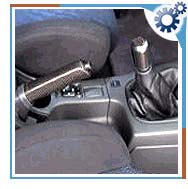 History
History Automobiles with manual transmission started in United States and Canada, where these transmissions are still used as standard transmissions.
All current manual transmissions employ a centrally located, floor-or-dash-mounted shift lever. In the past the term "three on the tree" was used for a manual shift lever located on the steering column.
Introduction
A manual transmission is a transmission that uses different sets of gears to change the gear ratio. The manual transmission locks and unlocks different sets of gears to the output shaft to achieve the various gear ratios. The transmission changes the engine's speed and torque in relation to the speed and torque of the drive wheels. This keeps the engine's output matched as close as possible to varying road speeds and loads.
Manual transmissions are most commonly used in sports car. They allow a greater proportion of the engine's power to be used, and because they give drivers the greatest possible degree of control over the operation of the vehicle's power train. To reduce cost, and also to compensate for smaller engines, manual transmissions are commonly chosen for compact cars.
Types
There are two basic types of manual transmissions:
Slide-gear type - In this transmission, only the main drive gear and cluster gear when the trans is in neutral enters the transmission case. To move the vehicle, clutch pedal is pressed, shifter is moved, which in turn moves the shift linkage and forks to slide a gear along the mainshaft. Clutch pedal is released once the gears are meshed and the power is sent to the drive wheels.
Constant-mesh type - All the main shaft gears are in constant mesh with the cluster gears because the gears on the main shaft are free to rotate on the shaft. In this type, even when the transmission is in neutral, the gearbox, cluster gear, drive gear and all the main shaft gears are always turning.
Maintenance
Because clutches use changes in friction to modulate the transfer of torque between engine and transmission, they are subject to wear in everyday use. A very good clutch, when used by an expert driver, can last hundreds of thousands of kilometers, whereas weak clutches or inexperienced drivers can lead to more frequent repair or replacement.
Manual transmissions are lubricated with gear oil, which must be changed periodically.